
Ten days shy of a full year since he departed Earth, NASA’s Mark Vande Hei is safely back on terra firma, following Wednesday’s successful landing of Soyuz MS-19 on the desolate steppe of south-central Kazakhstan. Riding shoulder-to-shoulder with Russian cosmonauts Anton Shkaplerov and his one-year buddy Pyotr Dubrov, Vande Hei wrapped up America’s longest single human spaceflight, smashing Scott Kelly’s earlier 340-day record from his 2015-2016 “One Year Mission”. With Soyuz MS-19’s safe return, Vande Hei has now logged 355 days, three hours and 45 minutes in space, since his launch last 9 April.
“Mark’s mission is not only record-breaking, but also paving the way for future human explorers on the Moon, Mars and beyond,” said NASA Administrator Bill Nelson. “Our astronauts make incredible sacrifices in the name of science, exploration, and cutting-edge technology development, not least among them time away from loved ones. NASA and the nation are proud to welcome Mark home and grateful for his incredible contributions throughout his year-long stay on the International Space Station.”
Spending up to a year in orbit on the ISS was first demonstrated by Kelly and Russia’s Mikhail Kornienko, whose 340-day mission concluded in March 2016. Although ultra-long-duration flights had been done before—notably, cosmonaut Valeri Polyakov spent 430 days aboard Russia’s Mir space station between January 1994 and March 1995—the stay of Kelly and Kornienko marked the first year-long mission of the 21st century.
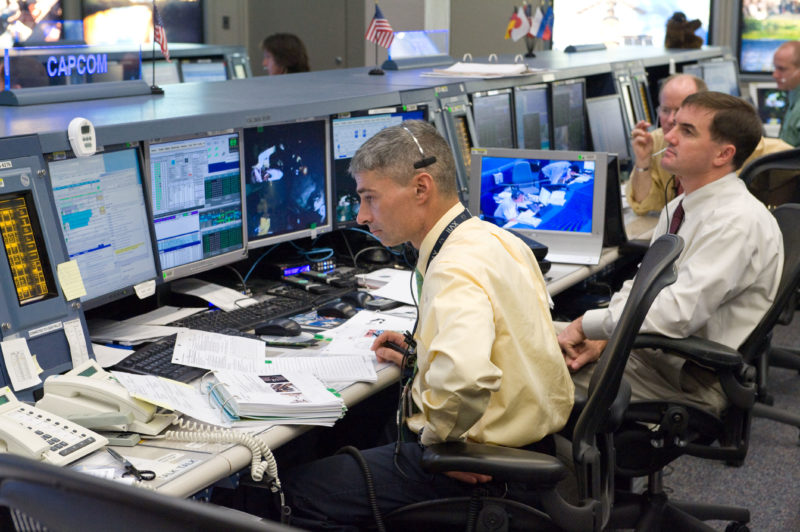
Since then, U.S. astronaut Peggy Whitson wrapped up almost ten months in orbit between November 2016 and September 2017. And between March 2019 and February 2020 Christina Koch set a new record of 328 days on the longest single spaceflight ever performed by a woman. More recently, Koch’s crewmate Drew Morgan chalked up almost nine months in space during his own ISS increment between July 2019 and April 2020.
With ISS operations extended through 2030, the next ultra-long-duration mission beyond that of Vande Hei remains to be determined. “We are continuing to identify additional studies for future one-year missions and do intend to continue flying them,” NASA’s Dan Huot told AmericaSpace. “Exact timing being figured out still and none currently scheduled.”
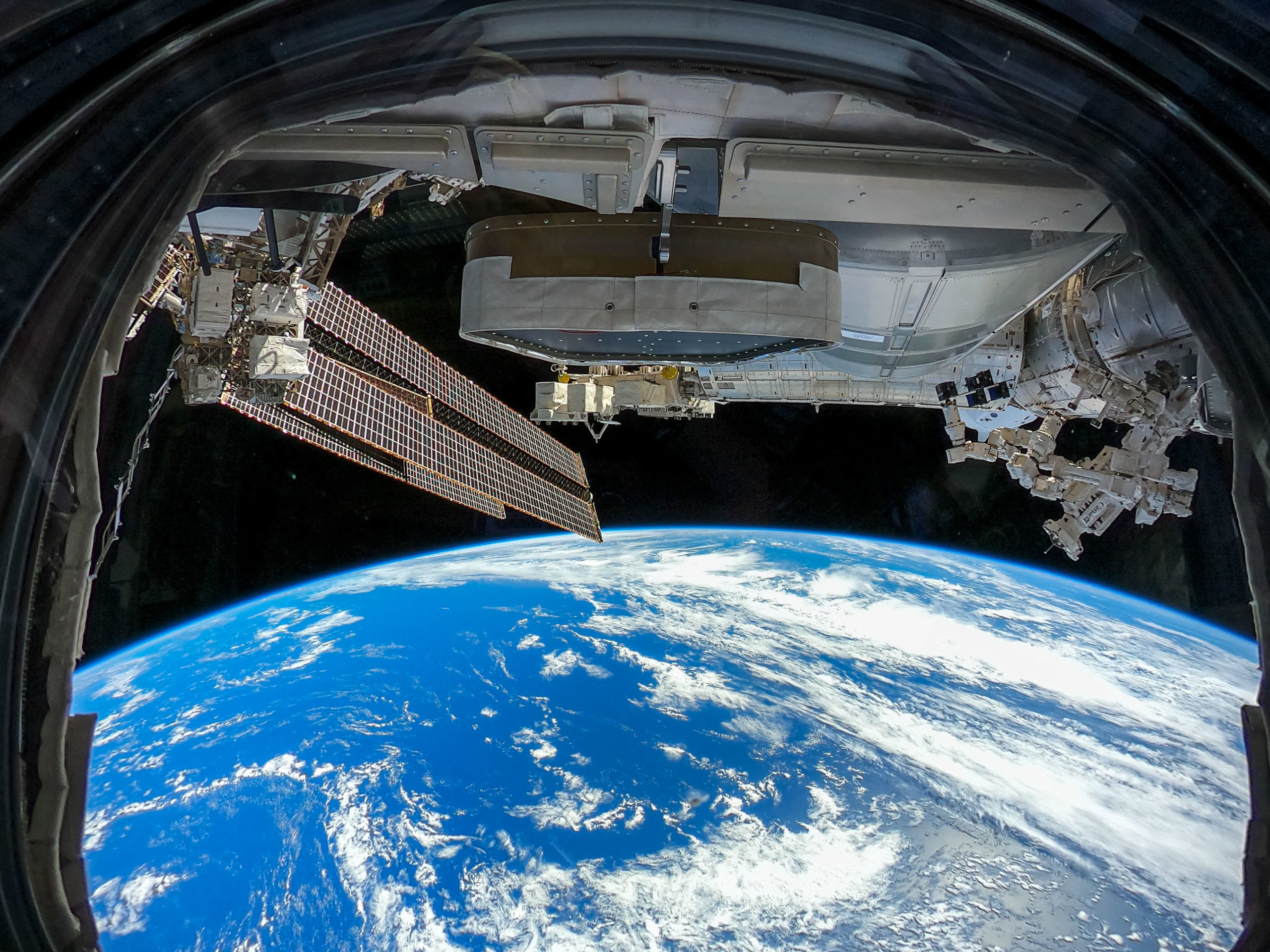
The ultra-long-duration missions of Vande Hei, Morgan and Koch are built on the foundation of NASA’s Standard Measures study, which seeks to achieve a uniform approach to measuring the effects of spaceflight on the human body. Core focuses include behavioral health and performance, cellular and immunology profiling, microbiology and biochemistry, sensorimotor and cardiovascular.
Broadly, these focuses investigate the vestibular system and astronauts’ ability to achieve balance and body control, which will be of crucial importance on future voyages to the Moon and Mars. The astronauts’ health at cellular and molecular levels has been comprehensively explored through examination of pre-flight, in-flight and post-flight biochemical markers, together with cellular profiling to understand the adaptation of the immune system to the microgravity environment. Personality surveys and the risks posed by interpersonal conflicts are being used to devise strategies for future missions into deep space and the astronauts’ mental alertness has been monitored through a suite of cognitive tasks.
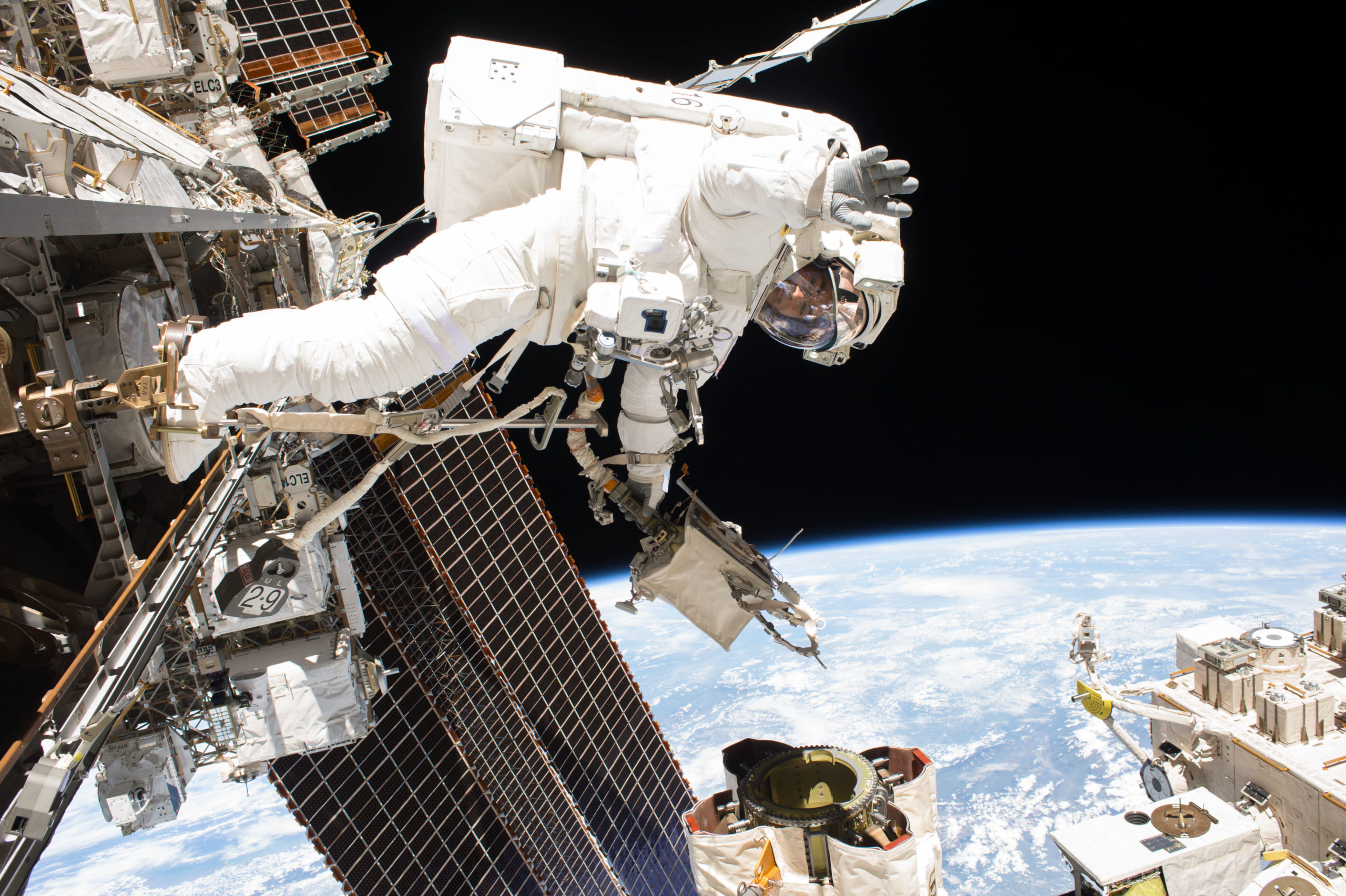
During his increment, Vande Hei was also the first ultra-long-duration subject of NASA’s Food Physiology survey, which seeks to compare astronauts’ current on-orbit diets with an “enhanced” diet, packed with nutrients such as flavonoids, lycopene and omega-3 fatty acids. This enhanced diet is more diverse in foods rich in bioactive compounds (such as fruits, vegetables and fish) than standard space fare and required Vande Hei to log his daily intake.
Each week, he discussed the diet with ground specialists and blood, urine, saliva and fecal samples were taken before, during and after the mission. Previous contributors to the Food Physiology survey were Expedition 63’s Chris Cassidy and SpaceX Crew-1’s Victor Glover, although neither spent longer than six months in orbit.
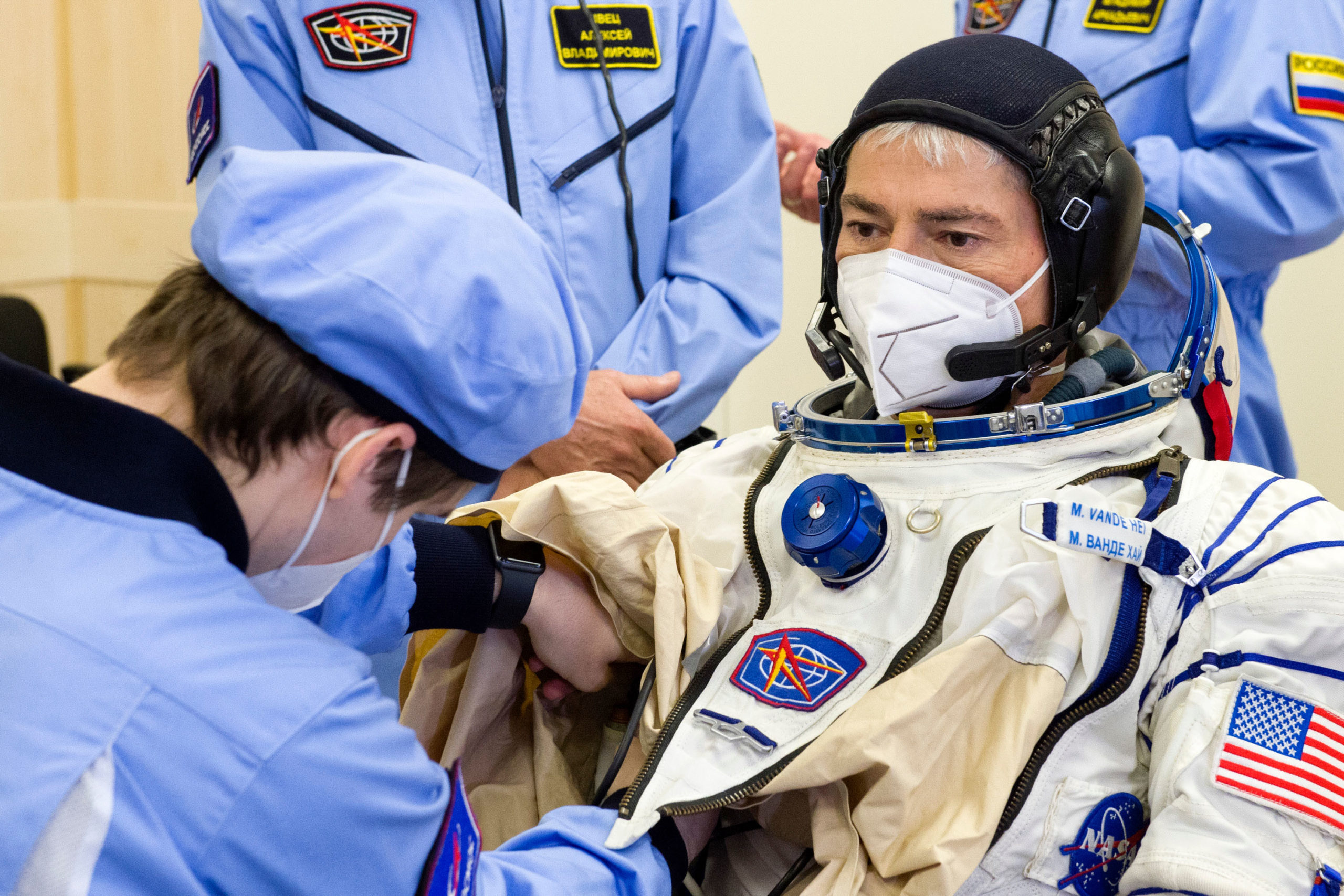
Across his two space missions, Vande Hei has accrued 523 days in space, which positions the retired U.S. Army colonel in 23rd place on the list of the world’s most flight-experienced spacefarers. He also sits in third place behind Peggy Whitson and Jeff Williams on the list of America’s most seasoned astronauts.
Selected as a member of NASA’s 20th class of astronauts—“The Chumps”—back in June 2009, Vande Hei was previously an ISS flight controller from the Army detachment at the Johnson Space Center (JSC) in Houston, Texas. After completing initial Astronaut Candidate (ASCAN) training, he pulled backup duty on Soyuz MS-02, launched in October 2016. And following several crew line-up changes, Vande Hei launched aboard Soyuz MS-06 in September 2017, flying shoulder-to-shoulder with Russia’s Aleksandr Misurkin and fellow NASA astronaut Joe Acaba.
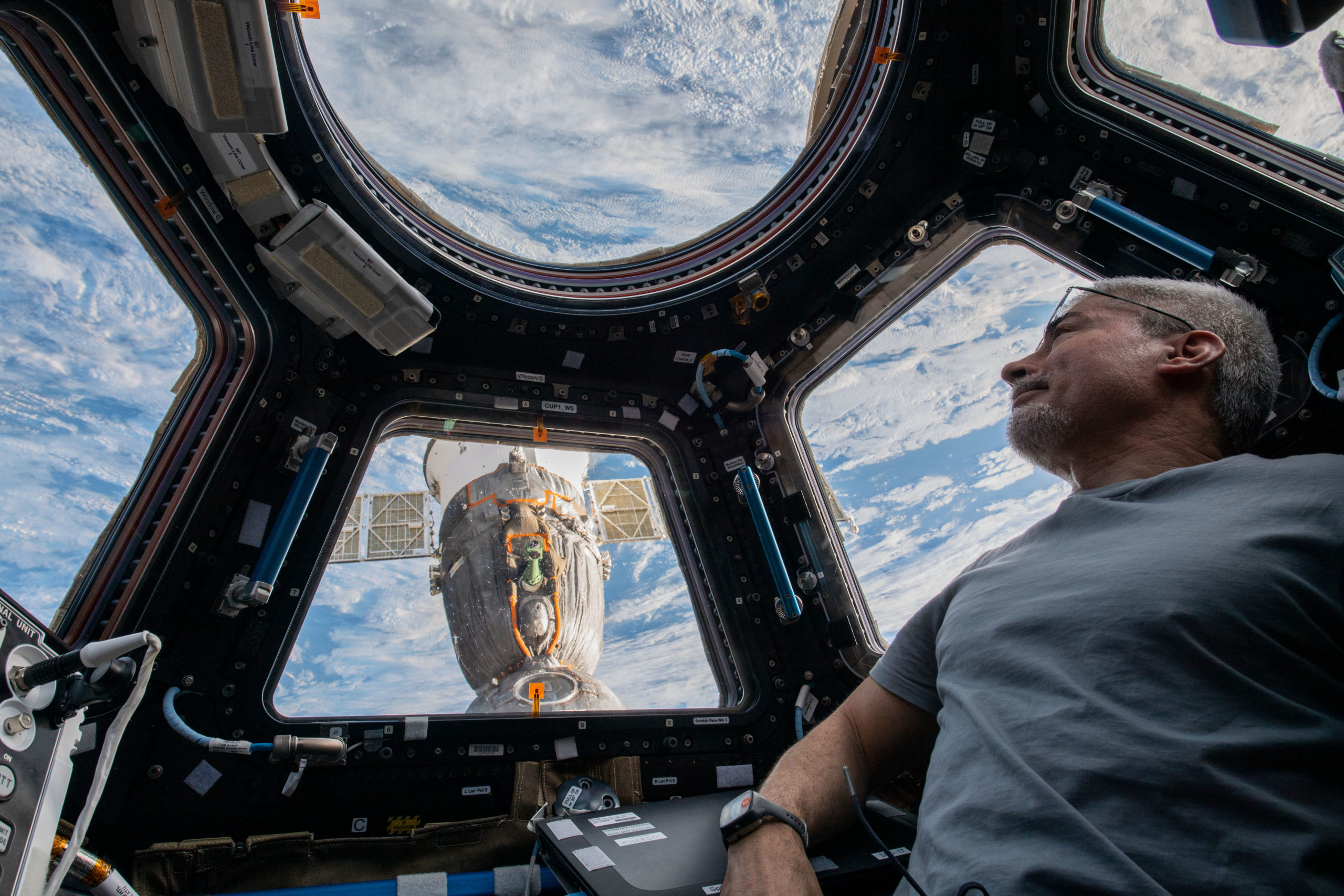
During his first mission, Vande Hei’s increment spanned Expeditions 53 and 54 and saw him perform four sessions of Extravehicular Activity (EVA), totaling 26 hours and 42 minutes. He also supported dozens of research investigations, including the manufacturing of fiber-optic filaments in microgravity, improving the accuracy of an implantable glucose biosensor and measuring the Sun’s energy input to Earth.
Returning to Earth with Misurkin and Acaba in February 2018, Vande Hei logged 168 days in space and more than 2,600 orbits of the Home Planet. His subsequent assignments in the Astronaut Office included a post as assistant to the chief for EVA and Robotics in 2019-2020, before he was assigned—with surprisingly short notice—to Soyuz MS-18 in the spring of 2021. With two seats on the fall 2021 Soyuz mission set to be taken by a Russian film producer and actress, it was readily apparent before launch that Vande Hei and his MS-18 crewmate Pyotr Dubrov would likely be asked to pull a double-duty increment of nearly one full year on the ISS.

Vande Hei, Dubrov and Soyuz MS-18 commander Oleg Novitsky arrived at the station after a 3.5-hour, two-orbit “ultra-fast rendezvous” to be greeted by the Expedition 64 crew of Russian cosmonauts Sergei Ryzhikov and Sergei Kud-Sverchkov, NASA’s Kate Rubins, Mike Hopkins, Victor Glover and Shannon Walker and Japanese astronaut Soichi Noguchi. A few days later, Ryzhikov, Kud-Sverchkov and Rubins returned to Earth and Vande Hei et. al. rotated into Expedition 65, under the command of Walker.
And when SpaceX’s Dragon Endeavour launched and docked in late April, Expedition 65 was temporarily boosted to 11 members with the arrival of NASA astronauts Shane Kimbrough and Megan McArthur, plus France’s Thomas Pesquet and Japan’s Aki Hoshide. In early May, Walker, Hopkins, Glover and Noguchi returned to Earth aboard their trusty ship, SpaceX’s Dragon Resilience and the ISS again settled into standard seven-crew operations, under the command of Hoshide.
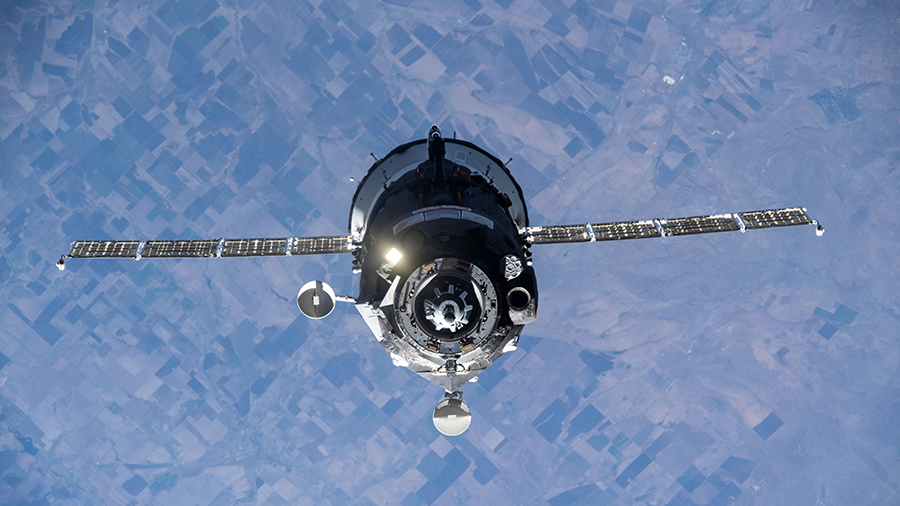
A busy increment lay ahead. During Vande Hei’s time on the station, he welcomed eight unpiloted visiting vehicles—three Russian Progress ships, three SpaceX Cargo Dragons and two Northrop Grumman Corp. Cygnuses—and bade farewell to eight. He was aboard the ISS last July during the troubled arrival of Russia’s long-awaited Nauka lab and also welcomed the Prichal docking node, the station’s latest permanent component, last November. But Vande Hei did not get to see the arrival of the second uncrewed Orbital Flight Test (OFT-2) of Boeing’s CST-100 Starliner, which suffered technical issues prior to its planned July 2021 launch and is now not expected to fly before May 2022.
In addition to uncrewed visitors, Vande Hei welcomed four crew-carrying spacecraft: two Crew Dragons, including the arrival of NASA’s Raja Chari, Tom Marshburn and Kayla Barron, together with German astronaut Matthias Maurer last November on Crew-3, and a pair of short-duration Soyuz flights last October and December. The first of those Soyuz flights included Russian film director Klim Shipenko and actress Yulia Peresild, the second a pair of Japanese tourists, Yusaku Maezawa and Yozo Hirano. Both pairs of tourists were accompanied by a professional Russian cosmonaut: Anton Shkaplerov on October’s Soyuz MS-19 and Aleksandr Misurkin on December’s Soyuz MS-20.
And although Vande Hei and Dubrov would spend their year in space together, their original commander, Oleg Novitsky, did not, returning home aboard Soyuz MS-18 in October with Shipenko and Peresild. With the departure of Soyuz MS-18, Expedition 66 officially got underway, initially under Thomas Pesquet’s command, then under Anton Shkaplerov. And Shkaplerov would join Vande Hei and Dubrov on their searing hypersonic re-entry and return to Earth this morning.
All told, Vande Hei’s stay has spanned three consecutive ISS expeditions and he has lived and worked with 26 other humans from the United States, Russia, Japan, France and Germany. He supported hundreds of research investigations, which ran the gamut from studies of cotton-root systems to investigations into treatments for Alzheimer’s disease and a technology demonstration of a portable ultrasound device. But hopes of a fifth career EVA last September sadly came to nought, when he suffered a pinched nerve in his neck and Thomas Pesquet went outside in his stead with Hoshide.
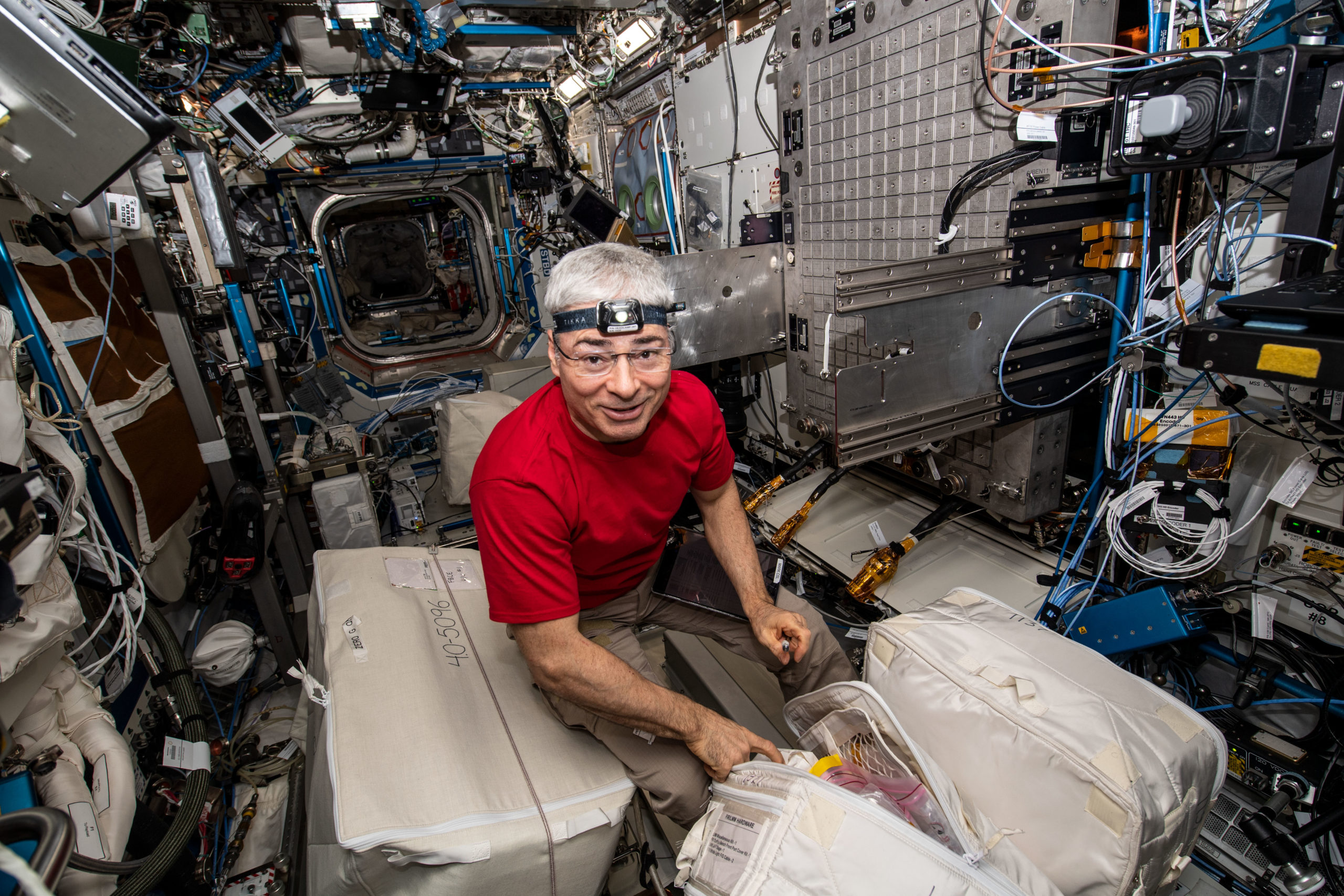
Earlier this month, he passed U.S. astronaut Christina Koch’s 328-day record for the longest single spaceflight ever undertaken by a woman. “How’s Day 329?” Koch jokingly asked in a 4 March tweet. “I wouldn’t know.” And just two weeks ago, Vande Hei passed Scott Kelly’s empirical 340-day record for the longest single spaceflight by a U.S. citizen. “Broken records indicate progress,” tweeted Kelly on 15 March. “Looking forward to seeing you safely home soon. Ad Astra!”
Last Saturday, Vande Hei passed a career total of 520 days in space across his two missions, eclipsing Kelly’s own career total and positioning himself in third place on the list of the most flight-experienced U.S. astronauts. Only Jeff Williams (with 534 days) and former NASA Chief Astronaut, the first female commander of a space station and America’s most seasoned female spacewalker Peggy Whitson (with 665 days) stand ahead of him. With today’s return to Earth, Vande Hei has accrued just over 523 days in orbit.
Yesterday, Shkaplerov formally relinquished command of the outgoing Expedition 66 increment to Marshburn, who will now lead Expedition 67 through his own crew’s return to Earth late next month. In his words at the change-of-command ceremony, Shkaplerov described his own half-year on the ISS as a “very interesting story” and downplayed a number of incidents, including—“some satellites tried to kill us”—a light-hearted reference to last November’s anti-satellite missile test by Russia.
A watered-down reference to the ongoing conflict in Ukraine was evident in Shkaplerov’s carefully guarded words, in which he praised the station as a “symbol of friendship”, a “symbol of future exploration of space” and honored his crewmates as his “space brothers and space sister”. He then presented the ceremonial “key” of the ISS—a Russian hatch-opening tool—to Marshburn, who called the moment an “honor and a privilege”, before paying tribute to Shkaplerov’s “dedication to the safety of the station”.
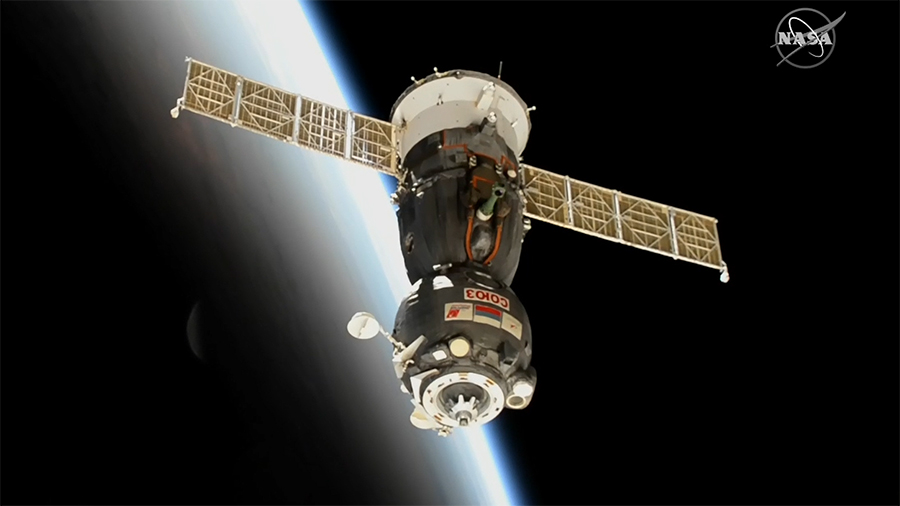
Soyuz MS-19, bearing Shkaplerov, Dubrov and Vande Hei, undocked from the ISS at 3:21 a.m. EDT Wednesday. Following a picture-perfect deorbit “burn”, the spacecraft’s spherical orbital module and cylindrical instrument module were automatically jettisoned at 6:03 a.m. EDT, leaving the bell-shaped descent module alone to withstand the furnace heat of re-entry. “Entry Interface”—the point at which Soyuz MS-19 began to feel the tenuous effects of Earth’s sensible atmosphere—came a couple minutes later. It was, noted NASA’s Rob Navias, the first pull of gravity for Vande Hei and Dubrov in almost a full year.
The spacecraft passed smoothly through peak aerodynamic heating and exited the “plasma regime” at 6:12 a.m. EDT. By this time, search and rescue forces had reached the landing site and adopted a racetrack pattern around the predicted touchdown point. Descending beneath its orange-and-white parachute, Soyuz MS-19 hit terra firma at 6:28 a.m. EDT—5:28 p.m. local time, glinting in the late afternoon sunshine—at a point about 90 miles (150 kilometers) southeast of Jezkazgan in south-central Kazakhstan.
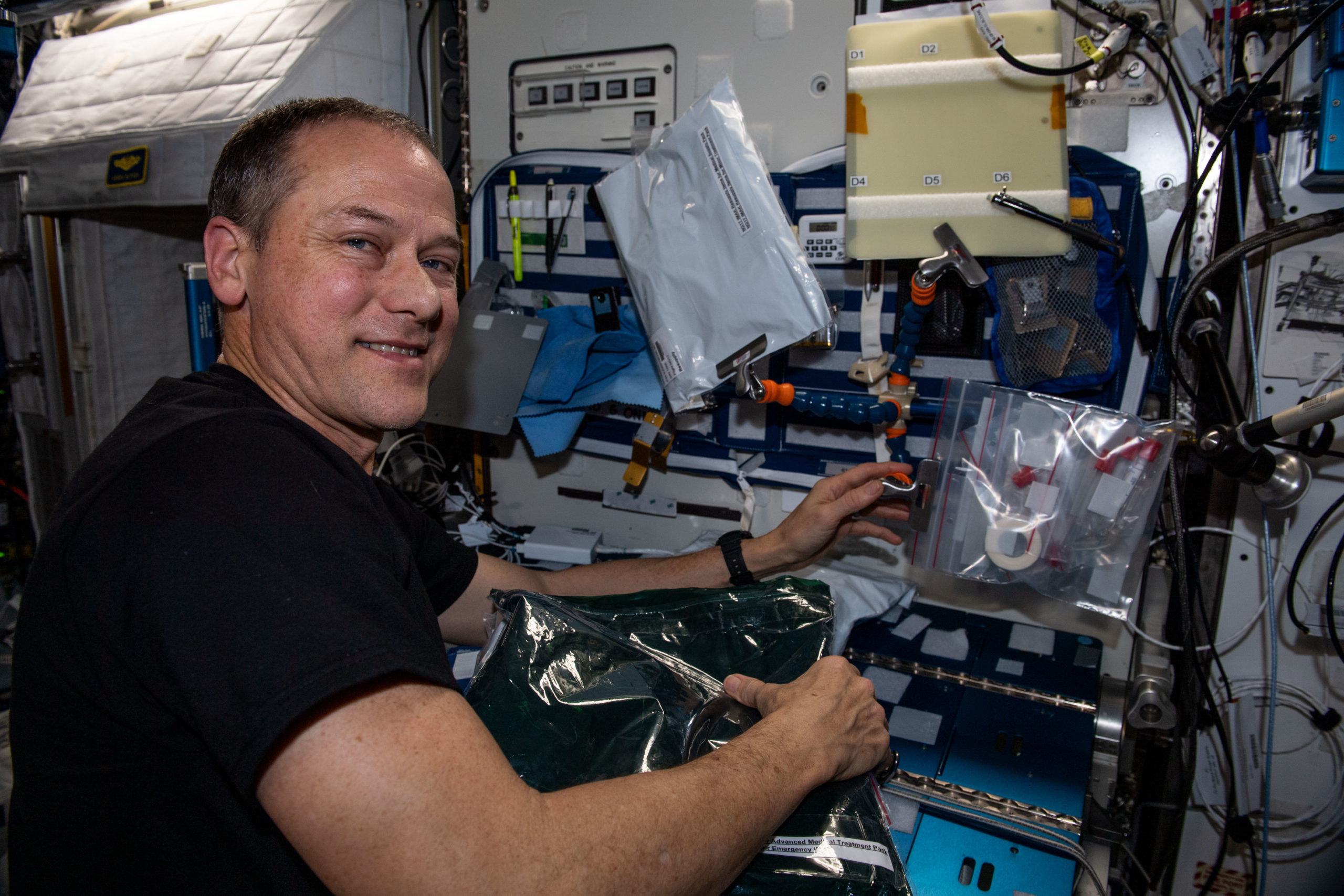
Under Marshburn’s command, the next major event for Expedition 67 is the arrival of Houston, Texas-based AxiomSpace, Inc.’s Ax-1 all-private crewed mission next week. Commanded by former NASA astronaut, America’s most experienced spacewalker and AxiomSpace senior executive Mike Lopez-Alegria, the Ax-1 crew includes entrepreneurs and philanthropists Larry Connor of the United States, Mark Pathy of Canada and Israel’s Eytan Stibbe. The quartet will perform around 25 scientific, educational and outreach experiments during their ten-day mission, which is expected to include eight days on the ISS.
Launch of Ax-1 aboard Dragon Endeavour was originally targeted for Sunday but has since slipped to no sooner than 12:05 p.m. EDT on Wednesday, 6 April. A Static Fire Test of the nine Merlin 1D+ first-stage engines of Ax-1’s previously-flown Falcon 9 booster on historic Pad 39A at the Kennedy Space Center (KSC) in Florida will occur on Monday. Assuming that Ax-1 flies next week, a full-duration mission will bring Dragon Endeavour to a parachute-assisted splashdown off the Florida Coast on the 16th.
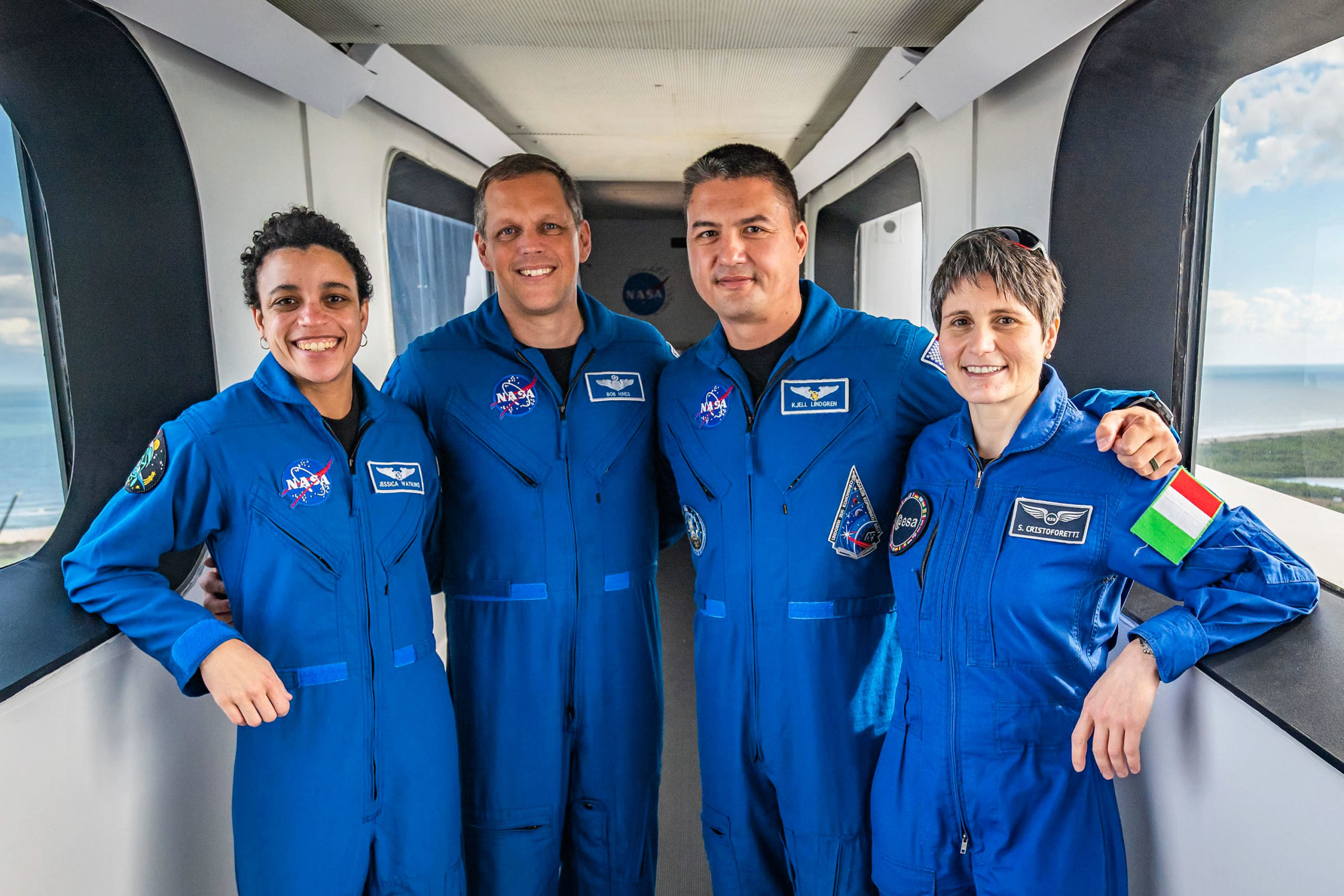
And that will set up the potential for a new landing-to-launch record in the annals of U.S. spaceflight history. With SpaceX’s brand-new Dragon Freedom due to lift Crew-4 astronauts Kjell Lindgren, Bob “Farmer” Hines and Jessica Watkins, together with Italy’s Samantha Cristoforetti, to the ISS on 19 April, a mere three days will elapse between the completion of one U.S. human space mission and the start of the next. That will easily surpass the previous record of just under six days which elapsed between the landing of shuttle Atlantis on 7 July 1995, following the first Mir docking mission, and the launch of her sister Discovery on the 13th, laden with a NASA communications satellite.
If Crew-4 launches as planned on the 19th, and docks at the ISS as planned on the 20th, the gears will whir into motion for the return of Marshburn, Chari, Barron and Maurer aboard Dragon Resilience around 25 April. They will close out 166 days in orbit, which has included dozens of research investigations and three U.S. spacewalks.





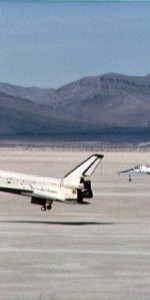
3 Comments
3 Pings & Trackbacks
Pingback:Vande Hei Discusses Longest Single U.S. Human Space Mission - AmericaSpace
Pingback:Crew-3 Returns Home, Wraps Up Six Months on Space Station - AmericaSpace
Pingback:NG-17 Cygnus Departs Space Station, Wraps Up Four-Month Stay - AmericaSpace